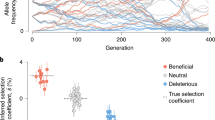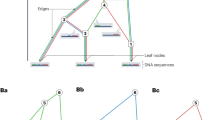Abstract
Understanding the variation of recombination rates across a given genome is crucial for disease gene mapping and for detecting signatures of selection, to name just a couple of applications. A widely-used method of estimating recombination rates is the maximum likelihood approach, and the problem of accurately computing likelihoods in the coalescent with recombination has received much attention in the past. A variety of sampling and approximation methods have been proposed, but no single method seems to perform consistently better than the rest, and there still is great value in developing better statistical methods for accurately computing likelihoods. So far, with the exception of some two-locus models, it has remained unknown how the true likelihood exactly behaves as a function of model parameters, or how close estimated likelihoods are to the true likelihood. In this paper, we develop a deterministic, parsimony-based method of accurately computing the likelihood for multi-locus input data of moderate size. We first find the set of all ancestral configurations (ACs) that occur in evolutionary histories with at most k crossover recombinations. Then, we compute the likelihood by summing over all evolutionary histories that can be constructed only using the ACs in that set. We allow for an arbitrary number of crossing over, coalescent and mutation events in a history, as long as the transitions stay within that restricted set of ACs. For given parameter values, by gradually increasing the bound k until the likelihood stabilizes, we can obtain an accurate estimate of the likelihood. At least for moderate crossover rates, the algorithm-based method described here opens up a new window of opportunities for testing and fine-tuning statistical methods for computing likelihoods.
Preview
Unable to display preview. Download preview PDF.
Similar content being viewed by others
References
Bafna, V., Bansal, V.: The number of recombination events in a sample history: conflict graph and lower bounds. IEEE/ACM Transactions on Computational Biology and Bioinformatics 1, 78–90 (2004)
Bafna, V., Bansal, V.: Improved Recombination Lower Bounds for Haplotype Data. In: Miyano, S., Mesirov, J., Kasif, S., Istrail, S., Pevzner, P.A., Waterman, M. (eds.) RECOMB 2005. LNCS (LNBI), vol. 3500, pp. 569–584. Springer, Heidelberg (2005)
Beaumont, M.: Detecting population expansion and decline using microsatellites. Genetics 153, 2013–2029 (1999)
Bordewich, M., Semple, C.: Computing the minimum number of hybridization events for a consistent evolutionary history. Discrete Applied Mathematics 155, 914–928 (2007)
De Iorio, M., Griffiths, R.C.: Importance sampling on coalescent histories. I. Adv. Appl. Prob. 36, 417–433 (2004)
De Iorio, M., Griffiths, R.C.: Importance sampling on coalescent histories. II: Subdivided population models. Adv. Appl. Prob. 36, 434–454 (2004)
Ethier, S.N., Griffiths, R.C.: The infinitely-many-sites model as a measure valued diffusion. Ann. Probab. 15, 515–545 (1987)
Ethier, S.N., Griffiths, R.C.: On the two-locus sampling distribution. J. Math. Biol. 29, 131–159 (1990)
Fearnhead, P., Donnelly, P.: Estimating recombination rates from population genetic data. Genetics 159, 1299–1318 (2001)
Fearnhead, P., Donnelly, P.: Approximate likelihood methods for estimating local recombination rates. J. R. Statist. Soc. B 64, 657–680 (2002)
Fearnhead, P., Smith, N.G.C.: A novel method with improved power to detect recombination hotspots from polymorphism data reveals multiple hotspots in human genes. Am. J. Hum. Genet. 77, 781–794 (2005)
Griffiths, R.C., Marjoram, P.: Ancestral inference from samples of DNA sequences with recombination. J. Comput. Biol. 3, 479–502 (1996)
Griffiths, R.C., Tavaré, S.: Ancestral inference in population genetics. Stat. Sci. 9, 307–319 (1994)
Griffiths, R.C., Tavaré, S.: Sampling theory for neutral alleles in a varying environment. Proc. R. Soc. London B. 344, 403–410 (1994)
Griffiths, R.C., Tavaré, S.: Simulating probability distributions in the coalescent. Theor. Popul. Biol. 46, 131–159 (1994)
Gusfield, D.: Optimal, efficient reconstruction of Root-Unknown phylogenetic networks with constrained recombination. J. Comput. Sys. Sci. 70, 381–398 (2005)
Gusfield, D., Eddhu, S., Langley, C.: The fine structure of galls in phylogenetic networks. INFORMS J. on Computing, special issue on Computational Biology 16, 459–469 (2004)
Gusfield, D., Eddhu, S., Langley, C.: Optimal, efficient reconstruction of phylogenetic networks with constrained recombination. J. Bioinf. Comput. Biol. 2, 173–213 (2004)
Hein, J.: Reconstructing evolution of sequences subject to recombination using parsimony. Math. Biosci. 98, 185–200 (1990)
Hein, J.: A heuristic method to reconstruct the history of sequences subject to recombination. J. Mol. Evol. 36, 396–405 (1993)
Hudson, R.R.: Generating Samples under the Wright-Fisher neutral model of genetic variation. Bioinformatics 18, 337–338 (2002)
Hudson, R., Kaplan, N.: Statistical properties of the number of recombination events in the history of a sample of DNA sequences. Genetics 111, 147–164 (1985)
Hudson, R.R.: Two-locus sampling distributions and their application. Genetics 159, 1805–1817 (2001)
International HapMap Consortium. A haplotype map of the human genome 437, 1299–1320 (2005)
Kuhner, M.K., Yamato, J., Felsenstein, J.: Estimating effective population size and mutation rate from sequence data using metropolis-hastings sampling. Genetics 140, 1421–1430 (1995)
Kuhner, M.K., Yamato, J., Felsenstein, J.: Maximum likelihood estimation of recombination rates from population data. Genetics 156, 1393–1401 (2000)
Larribe, F., Lessard, S., Schork, N.J.: Gene Mapping via the Ancestral Recombination Graph. Theor. Popul. Biol. 62, 2150–2229 (2002)
Li, N., Stephens, M.: Modeling linkage disequilibrium and identifying recombination hotspots using single-nucleotide polymorphism data. Genetics 165, 2213–2233 (2003)
Lyngsø, R.B., Song, Y.S., Hein, J.: Minimum recombination histories by branch and bound. In: Casadio, R., Myers, G. (eds.) WABI 2005. LNCS (LNBI), vol. 3692, pp. 239–250. Springer, Heidelberg (2005)
McVean, G., Awadalla, P., Fearnhead, P.: A coalescent-based method for detecting and estimating recombination from gene sequences. Genetics 160, 1231–1241 (2002)
McVean, G., Cardin, N.: Approximating the coalescent with recombination. Philos. Trans. R. Soc. Lond. B Biol. Sci. 360, 1387–1393 (2005)
McVean, G.A.T., Myers, S., Hunt, S., Deloukas, P., Bentley, D.R., Donnelly, P.: The fine-scale structure of recombination rate variation in the human genome. Science 304, 581–584 (2004)
Myers, S., Bottolo, L., Freeman, C., McVean, G., Donnelly, P.: A fine-scale map of recombination rates and hotspots across the human genome. Science 310, 321–324 (2005)
Myers, S.R., Griffiths, R.C.: Bounds on the minimum number of recombination events in a sample history. Genetics 163, 375–394 (2003)
Simonsen, K.L., Churchill, G.A.: A Markov chain model of coalescence with recombination. Theor. Popul. Biol. 52, 43–59 (1997)
Song, Y.S., Hein, J.: Parsimonious reconstruction of sequence evolution and haplotype blocks: Finding the minimum number of recombination events. In: Proc. of Workshop on Algorithms in Bioinformatics 2003, Berlin, Germany. LNCS, pp. 287–302. Springer, Berlin (2003)
Song, Y.S., Hein, J.: On the minimum number of recombination events in the evolutionary history of DNA sequences. J. Math. Biol. 48, 160–186 (2004)
Song, Y.S., Hein, J.: Constructing minimal ancestral recombination graphs. J. Comput. Biol. 12, 147–169 (2005)
Song, Y.S., Lyngsø, R.B., Hein, J.: Counting all possible ancestral configurations of sample sequences in population genetics. IEEE Transactions on Computational Biology and Bioinformatics 3(3), 239–251 (2006)
Song, Y.S., Wu, Y., Gusfield, D.: Efficient computation of close lower and upper bounds on the minimum number of needed recombinations in the evolution of biological sequences. In: Proc. of ISMB 2005, Bioinformatics, vol. 21, pp. 413–422 (2005)
Stephens, M., Donnelly, P.: Inference in molecular population genetics. J.R. Stat. Soc. Ser. B 62, 605–655 (2000)
Wall, J.D.: A comparison of estimators of the population recombination rate. Mol. Biol. Evol. 17, 156–163 (2000)
Wang, L., Zhang, K., Zhang, L.: Perfect phylogenetic networks with recombination. J. Comput. Biol. 8, 69–78 (2001)
Wilson, I.J., Balding, D.J.: Genealogical inference from microsatellite data. Genetics 150, 499–510 (1998)
Author information
Authors and Affiliations
Editor information
Rights and permissions
Copyright information
© 2008 Springer-Verlag Berlin Heidelberg
About this paper
Cite this paper
Lyngsø, R.B., Song, Y.S., Hein, J. (2008). Accurate Computation of Likelihoods in the Coalescent with Recombination Via Parsimony. In: Vingron, M., Wong, L. (eds) Research in Computational Molecular Biology. RECOMB 2008. Lecture Notes in Computer Science(), vol 4955. Springer, Berlin, Heidelberg. https://doi.org/10.1007/978-3-540-78839-3_41
Download citation
DOI: https://doi.org/10.1007/978-3-540-78839-3_41
Publisher Name: Springer, Berlin, Heidelberg
Print ISBN: 978-3-540-78838-6
Online ISBN: 978-3-540-78839-3
eBook Packages: Computer ScienceComputer Science (R0)




